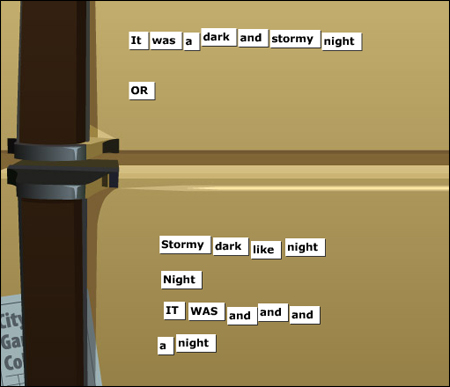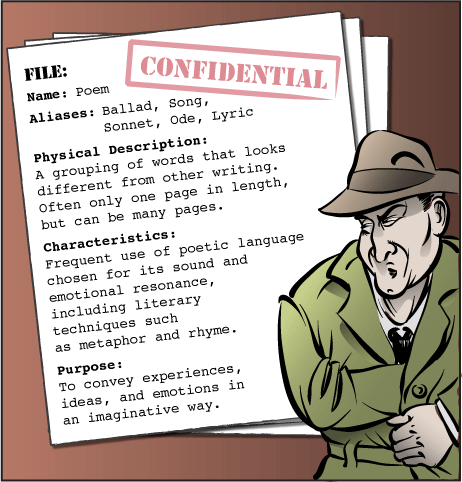Lesson 4.2A: Investigating Poetry

The first sentence is the often-mocked opening line of a melodramatic Victorian crime novel. The second grouping of sentences is one of a limitless number of possible poetic versions of the same sentence. Poetry comes in many shapes and sizes, but one of the best ways to understand poetry is to say what it is not - it is not groups of plain sentences and paragraphs. It is different from what we usually read.
In this lesson you will review poetic techniques and types, and then imagine yourselves as detectives, and the poems as suspects as you thoroughly interrogate two poems.
How to Detect a Poem
Poets might not agree on how to define a poem precisely, but some characteristics are easy to recognize. Here's the mug shot.

When you spot a poem, the next best thing you can do is read it and re-read it many times!
Poems are dodgy characters, and you need to really size them up to understand them. Once you've read them enough that you feel you can gather the courage to interrogate them, there are some crucial questions to ask.
The Usual Suspects
Poems surround themselves with a group of tricksters called literary or poetic devices. Some of the usual suspects are: alliteration, allusion, assonance, consonance, hyperbole, metaphor, simile, and personification.
 Go to the Literary Device Library and review these terms now. As you review each term, note how many of these devices sound. View each device twice - the first time viewing the image and reading the definition. The second time, close your eyes and simply listen. See if you can appreciate the impact sound on your ear or the formation of images in your mind. Go to the Literary Device Library and review these terms now. As you review each term, note how many of these devices sound. View each device twice - the first time viewing the image and reading the definition. The second time, close your eyes and simply listen. See if you can appreciate the impact sound on your ear or the formation of images in your mind.
Then and Now - Poetry is Poetry
The time has come to stop talking about poetry and to start actually reading and thinking about it! You are about to read the opening poems of your textbook. The first poem you will read, "Meditiation XVII" by John Donne, was originally written as a sermon by the poet in 1624 - the audience would have been the devout members of an upper class court in England. The second poem, "I am a Rock" by Paul Simon, is the lyrics to a pop song from 1965 - the audience was wide, but mostly young people of the rebellious sixties in North America.
These two poems have vastly different origins, and the language and style are quite different. Donne's tone is formal: the words he uses are sophisticated and the ideas are high-minded. In contrast, Simon's tone is colloquial: everyone understands the words he uses, and the style is plain, as if he is talking to a friend. Yet, here they lie side by side for your consideration. Why? Despite their differences, they are connected. Paul Simon was answering John Donne 341 years later; he had read Donne's words, and his lyrics were his answer, an argument against Donne's thinking. The poems share a deeply profound concern for how to live life. So let's line these two poems up and investigate how they do what they do.
 Let's begin by reading "Meditation XVII" and "I Am a Rock" on pages 2 and 3 of your Sightlines 10 textbook. Stop here and read each poem three times. Re-reading is an important way to enhance your experience of poetry. Let's begin by reading "Meditation XVII" and "I Am a Rock" on pages 2 and 3 of your Sightlines 10 textbook. Stop here and read each poem three times. Re-reading is an important way to enhance your experience of poetry.
Each time you read you will have a greater understanding, as you become more familiar with each layer of the poem. Use a pencil to underline any words that are unfamiliar. Look them up in a dictionary! |

To listen to a recording of this poem, go to Meditation XVII. After listening to this poem, reflect on how the oral reading helped you to understand it better.
The Metaphors Make These Poems
At the centre of both poems is a metaphor. A metaphor compares two essentially unlike things, and is a frequently used poetic device. For Donne, "no man is an island" (man ¦ island) and for Simon, "I am a rock, I am an island" (I = island). The poems take seemingly the exact opposite point of view.
These two poems speak to the theme of interconnectedness: how people are connected to each other. Donne believes that all people are interconnected; therefore, despite a person's social status, we should care for all people. On the other hand, Simon believes that there is no connection between people, as all individuals are "islands."
In his sonnet, Donne implores his upper-class audience to mourn the loss of any person, even a "clod" or unintelligent person, because all people are connected. He emphasizes and mirrors the theme of interconnectedness by using an extended metaphor, a comparison that runs through a whole poem. You will look more closely at this poem in a moment.
In Simon's pop classic, the singer chooses to be alone in his room "that none may penetrate" safe from love, and therefore from pain. We can guess that the speaker does not really believe that this is how we should all live. Instead, this is how he is feeling after having been hurt in some way - perhaps some one he knew has died, or a love has been lost.
Take a moment to examine the following image: a group of disparate people at a bus stop. Do you view these people as fundamentally connected, or simply, a collection of individuals? This is a matter of perspective - as Donne and Simon have different perspectives.

Interrogating Donne
When you do come face to face with a poem, you will need to be able to recognize more than just the literary terms it contains. In fact there are many more elements to a poem to consider, such as speaker, tone, and theme.
Donne's "Meditation XVII" is challenging to understand, but if you use the How to Interrogate a Poem template questions, you will quickly come to understand this old sonnet.
Watch how it works:
Click on the pdf, rtf or doc icon to view the How to Interrogate a Poem template.

How to Interrogate a Poem pdf |
By taking just a few minutes to break the poem into manageable pieces, we come out of the experience of interrogating a poem with a better understanding and appreciation of the whole poem.

Journal Entry 4.2A: Personal Connections to Poetry
In the journal section of the assignment template, answer the following questions:
The two poems you have just read, "Meditation XVII" and "I am a Rock," offer up two very different and emotional ideas about life. How do these poems connect with you? Can you relate better to the song lyrics from 1965, or the sermon from 300 years ago? How do poems and songs affect you? Do they make you feel happy, joyful, sad, lonely, and so on? Include some of your favourite lyrics if you like.
|
Discussion Prompt |
| Discuss the influence of song lyrics as the new poetry of our digital age. With the overwhelming presence of MP3 players and easy downloads of music, young people are spending a significant part of their lives drenched in the lyrics of current recording artists. Are these lyrics true poetry? Are lyrics changing lives for the better? What are lyrics teaching us about ourselves? |
Guidelines for contribution:
In a detailed paragraph outline three ideas you have in answer to these questions. If you can think of lyrics that are true poetry, post them for your classmates to consider. Respond to at least one other student's ideas or lyrics.
Click here to submit your entry to the forum now. |

Click here to download Section Assignment 4.2A Then complete Section A: Literary Device Study Guide in the assignment template.
|
Summary
Completing this lesson has helped you to:
- recognize the characteristics of a poem
- understand, recognize, and use metaphor
- generate a study guide of literary devices
- use questioning strategies to understand a poem
|

